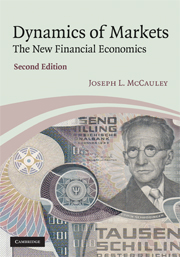Book contents
- Frontmatter
- Contents
- Preface to the second edition
- 1 Econophysics: why and what
- 2 Neo-classical economic theory
- 3 Probability and stochastic processes
- 4 Introduction to financial economics
- 5 Introduction to portfolio selection theory
- 6 Scaling, pair correlations, and conditional densities
- 7 Statistical ensembles: deducing dynamics from time series
- 8 Martingale option pricing
- 9 FX market globalization: evolution of the Dollar to worldwide reserve currency
- 10 Macroeconomics and econometrics: regression models vs empirically based modeling
- 11 Complexity
- References
- Index
8 - Martingale option pricing
Published online by Cambridge University Press: 02 December 2010
- Frontmatter
- Contents
- Preface to the second edition
- 1 Econophysics: why and what
- 2 Neo-classical economic theory
- 3 Probability and stochastic processes
- 4 Introduction to financial economics
- 5 Introduction to portfolio selection theory
- 6 Scaling, pair correlations, and conditional densities
- 7 Statistical ensembles: deducing dynamics from time series
- 8 Martingale option pricing
- 9 FX market globalization: evolution of the Dollar to worldwide reserve currency
- 10 Macroeconomics and econometrics: regression models vs empirically based modeling
- 11 Complexity
- References
- Index
Summary
Introduction
Betting is risky, and for noise traders financial markets are formalized gambling casinos. The idea of a bet is to take a risk in order to try for a big win. A hedge on the bet reduces the risk, reducing both the possible win and the possible loss. Buying stocks in both rain and beach umbrellas reflects the idea of a hedged bet. Options provide a more direct way of hedging a bet on a stock, bond, or FX. Even money, however, is risky, as inflation can occur and a currency can be degraded systematically by the policies of the government in charge.
A stock, bond, or a foreign currency is a risky paper “asset” because the price fluctuates freely against your local currency. A bank deposit in the local currency, CD, or money market account is called “risk free” in financial math texts. Obviously, that idealization ignores the riskiness of the local currency (which reflects a nation's financial and fiscal policies) against necessary imports like oil and food. The riskiness of the Dollar as the world's default reserve currency is discussed in Chapter 9. Here, we will write as if a local currency could be “risk-free.” We will ignore inflation and consider only local bank interest rates. In truth, because of market instability, nothing in finance is risk-free.
A bond is a loan at a fixed interest rate, and fluctuates in price in anticipation of changes in future money market interest rates.
- Type
- Chapter
- Information
- Dynamics of MarketsThe New Financial Economics, pp. 176 - 187Publisher: Cambridge University PressPrint publication year: 2009



